Publications
sorted in reversed chronological order.
2024
-
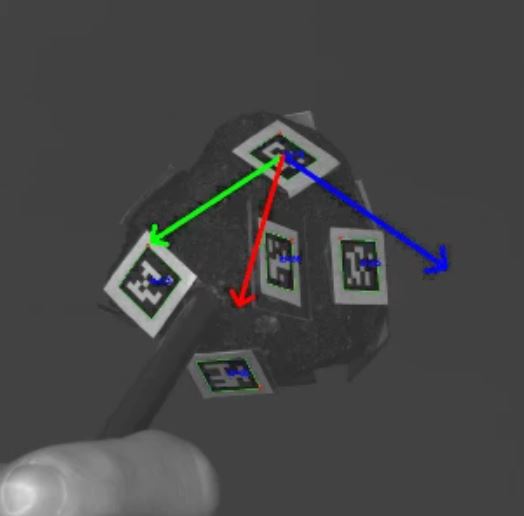 High-Accuracy 3D Locators Tracking in Real Time Using Monocular VisionC. Elmo Kulanesan, P. Vacher, L. Charleux, and 1 more author2024
High-Accuracy 3D Locators Tracking in Real Time Using Monocular VisionC. Elmo Kulanesan, P. Vacher, L. Charleux, and 1 more author2024In the field of medical applications, precise localization of medical instruments and bone structures is crucial to ensure computer-assisted surgical interventions. In orthopedic surgery, existing devices typically rely on stereoscopic vision. Their purpose is to aid the surgeon in screw fixation of prostheses or bone removal. This article addresses the challenge of localizing a rigid object consisting of randomly arranged planar markers using a single camera. This approach is especially vital in medical situations where accurate object alignment relative to a camera is necessary at distances ranging from 80 cm to 120 cm. In addition, the size limitation of a few tens of centimeters ensures that the resulting locator does not obstruct the work area. This rigid locator consists of a solid at the surface of which a set of plane markers (ArUco) are glued. These plane markers are randomly distributed over the surface in order to systematically have a minimum of two visible markers whatever the orientation of the locator. The calibration of the locator involves finding the relative positions between the individual planar elements and is based on a bundle adjustment approach. One of the main and known difficulties associated with planar markers is the problem of pose ambiguity. To solve this problem, our method lies in the formulation of an efficient initial solution for the optimization step. After the calibration step, the reached positioning uncertainties of the locator are better than two-tenth of a cubic millimeter and one-tenth of a degree, regardless of the orientation of the locator in space. To assess the proposed method, the locator is rigidly attached to a stylus of about twenty centimeters length. Thanks to this approach, the tip of this stylus seen by a 16.1 megapixel camera at a distance of about 1 m is localized in real time in a cube lower than 1 mm side. A surface registration application is proposed by using the stylus on an artificial scapula.
@article{CE_LC_PV_ER_3D_loc_2024, title = {High-Accuracy {{3D}} Locators Tracking in Real Time Using Monocular Vision}, author = {Elmo~Kulanesan, C. and Vacher, P. and Charleux, L. and Roux, E.}, date = {2024-01-11}, journaltitle = {Machine Vision and Applications}, shortjournal = {Machine Vision and Applications}, volume = {35}, year = {2024}, number = {2}, pages = {17}, issn = {1432-1769}, doi = {10.1007/s00138-023-01498-9}, url = {https://doi.org/10.1007/s00138-023-01498-9}, urldate = {2024-01-15}, langid = {english}, keywords = {3D locators,3D tracking,Aruco,Monocular vision,Planar marker}, } -
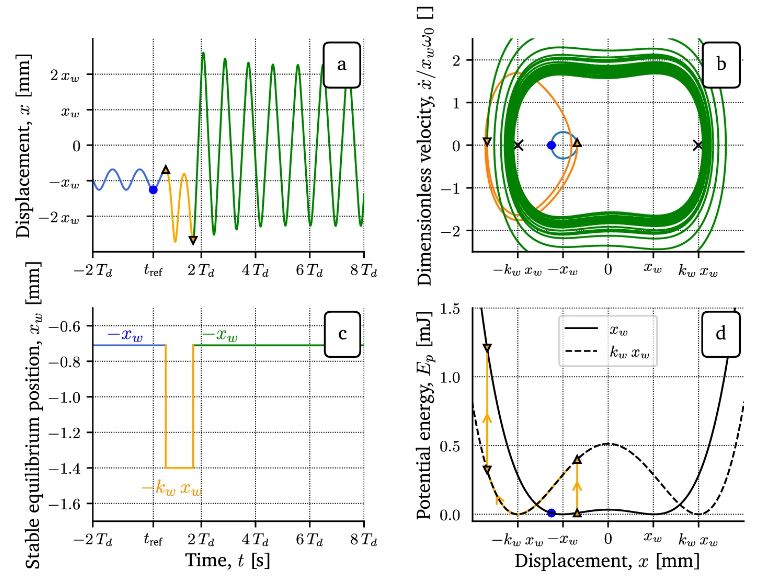 Optimized and Robust Orbit Jump for Nonlinear Vibration Energy HarvestersCamille Saint-Martin, Adrien Morel, Ludovic Charleux, and 4 more authors2024
Optimized and Robust Orbit Jump for Nonlinear Vibration Energy HarvestersCamille Saint-Martin, Adrien Morel, Ludovic Charleux, and 4 more authors2024This paper introduces an optimized orbit jump strategy for nonlinear vibration energy harvesters (VEHs). Nonlinear VEHs are a promising alternative to linear VEHs due to their broadband characteristics. However, they exhibit complex dynamical behaviors, including not only high-power inter-well orbits but also low-power intra-well orbits and chaos. The existence of low-power orbits in their dynamics can restrict their energy harvesting performance. In order to overcome this issue, this study investigates an orbit jump strategy that allows the VEH to transition from low-power intra-well orbits to high-power inter-well orbits. The orbit jump strategy, which is based on varying the buckling level of a bistable VEH, has been previously studied but not yet optimized. In this study, we optimize this orbit jump strategy to ensure practical reproducibility and robustness against variations in parameters or excitation. Through the combination of thorough experimental identification and high-performance computing of the complex transients during orbit jumps, we achieved high numerical accuracy in orbit jump modeling. This was possible by a developed Python CUDA code using GPU parallel computing to handle a large number of numerical resolutions of the nonlinear VEH model. These simulations facilitate the optimization of both the robustness and the energy cost of orbit jumps, based on a novel numerical criterion. Experimental tests were performed on a bistable VEH over a frequency range of 30 Hz, validating the numerical results obtained with the optimized orbit jump strategy. Experimental results show an average success rate of 48%, despite a variation of \\\pm 15\%\∈the starting and ending times of the jump, leading to a robust and optimized orbit jump strategy. The proposed optimization procedure can be applied to other orbit jump strategies, and other types of nonlinear VEHs. The results indicate that the energy consumption required for a successful orbit jump ranges between 0.2 and 1 mJ, and can be restored within 0.2 s in the worst case.
@article{CS_OptimizedRobustOrbit2024, title = {Optimized and Robust Orbit Jump for Nonlinear Vibration Energy Harvesters}, author = {Saint-Martin, Camille and Morel, Adrien and Charleux, Ludovic and Roux, Emile and Gibus, David and Benhemou, Aya and Badel, Adrien}, date = {2024-01-08}, year = {2024}, journaltitle = {Nonlinear Dynamics}, shortjournal = {Nonlinear Dyn}, issn = {1573-269X}, doi = {10.1007/s11071-023-09188-x}, url = {https://doi.org/10.1007/s11071-023-09188-x}, urldate = {2024-01-15}, langid = {english}, keywords = {Bistability,Buckling adjustments,Energy harvesting,GPU parallel computing,Nonlinear dynamics,Optimization,Orbit jump} } -
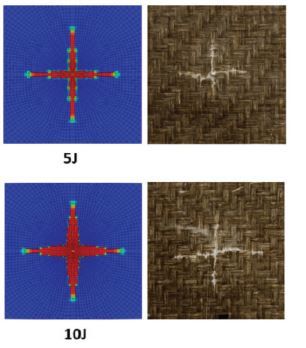 Numerical modeling of flax-woven reinforced composites submitted to quasi-static indentation and low velocity impactAdélaïde Leroy, Daniel Scida, Émile Roux, and 2 more authorsInternational Journal of Damage Mechanics, 2024
Numerical modeling of flax-woven reinforced composites submitted to quasi-static indentation and low velocity impactAdélaïde Leroy, Daniel Scida, Émile Roux, and 2 more authorsInternational Journal of Damage Mechanics, 2024The aim of this paper is to provide a numerical modeling tool for flax-woven reinforced laminates submitted to Low Velocity Impact (LVI) and Quasi-Static Indentation (QSI). The selected approach is based on a constitutive material model specifically developed for woven reinforced plies. Experimental tests were carried out at different energy levels and boundary conditions for a comparative study to assess the viability of the model. Numerical results provide a good estimation of experimental force-displacement curves, with good to excellent superposition for LVI at 10 and 15 J and for QSI until a displacement of 2 to 3.5 mm. In terms of visible damage, a parallel is drawn between some damage variables and visible cracks on the one hand, and element deletions and fiber bundle failures on the other hand. Results show that the proposed numerical model is promising and potentially useful for designing and optimizing flax-woven reinforced composites submitted to both LVI and QSI.
@article{Leroy_2024, author = {Leroy, Adélaïde and Scida, Daniel and Roux, Émile and Toussaint, Franck and Ayad, Rezak}, title = {Numerical modeling of flax-woven reinforced composites submitted to quasi-static indentation and low velocity impact}, journal = {International Journal of Damage Mechanics}, volume = {0}, number = {0}, pages = {10567895241258874}, year = {2024}, doi = {10.1177/10567895241258874}, url = { https://doi.org/10.1177/10567895241258874}, } -
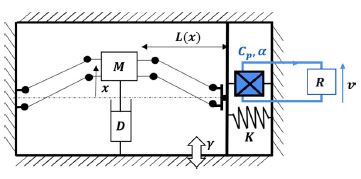 Predictive lumped model for a tunable bistable piezoelectric energy harvester architectureAya Benhemou, David Gibus, Thomas Huguet, and 6 more authorsSmart Materials and Structures, Mar 2024
Predictive lumped model for a tunable bistable piezoelectric energy harvester architectureAya Benhemou, David Gibus, Thomas Huguet, and 6 more authorsSmart Materials and Structures, Mar 2024In this article, we propose the modelling of a tunable bistable piezoelectric energy harvester (or BPEH) architecture. The latter is a type of ambient energy converter that continues to gain attention due to their wideband frequency response. As the non-linear dynamics of BPEHs imply significant modeling complexity, dynamic lumped models are necessary to predict BPEHs’ dynamic response and should fit the type of architecture studied. The BPEH architecture of interest uses post-buckled beams to create bistability and an amplified piezoelectric actuator (or APA) to convert the ambient vibrations. To date, no dynamic lumped models have been found in existing literature that account for both the electromechanical conversion and the dynamic behavior of buckled beams, with a specific focus on their axial and bending stiffness, for this BPEH architecture. Additionally, the proposed BPEH architecture offers buckling level tunability, which is achieved using an additional APA. Hence, the aim of this paper is to propose a new lumped model for a BPEH architecture that considers the effect of the post-buckled beams’ stiffness and of the additional APA through an elasticity factor . This lumped model is established using Euler Lagrange equations and is experimentally validated on a tunable BPEH prototype. This validation shows an average relative error below 6% between the model predictions and experimental dynamic response of the prototype to an ascending frequency sweep, compared to an average relative error that is around 14% for the model proposed in literature. Moreover, numerical simulations using the proposed model lead to the conclusion that there is an optimal elasticity factor that ensures the maximum power output while maintaining the frequency bandwidth.
@article{Benhemou_2024, doi = {10.1088/1361-665X/ad2c6a}, url = {https://dx.doi.org/10.1088/1361-665X/ad2c6a}, year = {2024}, month = mar, publisher = {IOP Publishing}, volume = {33}, number = {4}, pages = {045033}, author = {Benhemou, Aya and Gibus, David and Huguet, Thomas and Morel, Adrien and Demouron, Quentin and Saint-Martin, Camille and Roux, Emile and Charleux, Ludovic and Badel, Adrien}, title = {Predictive lumped model for a tunable bistable piezoelectric energy harvester architecture}, journal = {Smart Materials and Structures}, }
2023
-
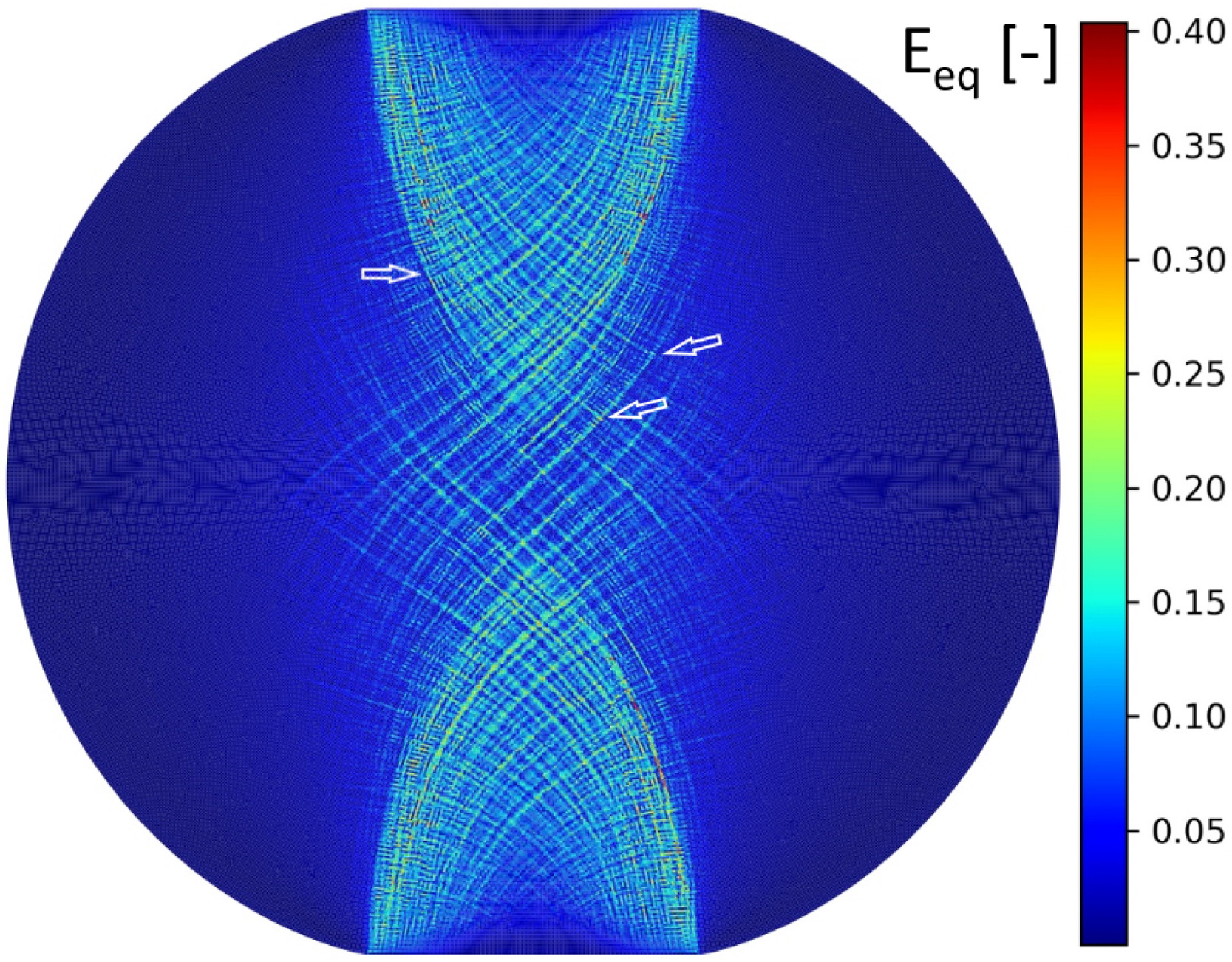 Intense shear band plasticity in metallic glass as revealed by a diametral compression testC. Bernard, S. Hin, L. Charleux, and 4 more authorsMaterials Science and Engineering: A, Feb 2023
Intense shear band plasticity in metallic glass as revealed by a diametral compression testC. Bernard, S. Hin, L. Charleux, and 4 more authorsMaterials Science and Engineering: A, Feb 2023Shear band initiation, development and mutual interaction are studied in a Zr55Cu30Al10Ni5 metallic glass by means of an innovative experimental technique associating diametral compression test (or Brazilian test), scanning electron microscopy and digital image correlation analysis. The intense strain occurring in shear bands and the deformation map of their overall pattern are both estimated with a high resolution (∼ 5 μm/pixel), offering a better understanding of the phenomenon. Finite element simulations based on a new and original plasticity model, the compartmentalized model, makes it possible to reproduce the shear band development observed experimentally, as well as the interlocking mechanism occurring between the shear bands.
@article{bernard2023, title = {Intense shear band plasticity in metallic glass as revealed by a diametral compression test}, volume = {864}, issn = {09215093}, url = {https://linkinghub.elsevier.com/retrieve/pii/S092150932201913X}, doi = {10.1016/j.msea.2022.144533}, language = {en}, urldate = {2023-03-27}, journal = {Materials Science and Engineering: A}, author = {Bernard, C. and Hin, S. and Charleux, L. and Roux, E. and Yokoyama, Y. and Tanguy, A. and Keryvin, V.}, month = feb, year = {2023}, pages = {144533}, keywords = {acc}, file = {Bernard et al. - 2023 - Intense shear band plasticity in metallic glass as.pdf:C\:\\Users\\rouxemi\\Zotero\\storage\\JR22RLAG\\Bernard et al. - 2023 - Intense shear band plasticity in metallic glass as.pdf:application/pdf}, } -
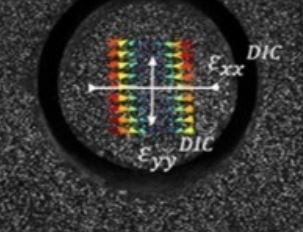 In situ DIC method to determine stress state in reinforced concrete structuresMarie Allain, Olivier Ple, Noémie Prime, and 2 more authorsMeasurement, Mar 2023
In situ DIC method to determine stress state in reinforced concrete structuresMarie Allain, Olivier Ple, Noémie Prime, and 2 more authorsMeasurement, Mar 2023Nowadays these structures are at the end of their theoretical life according to Eurocode 2. It is entitled to ask questions about their state of health, and whether these structures are still able to ensure their activity in respect of constantly evolving regulations, while ensuring public safety. To tender to answer these questions, we have developed a new method for analyzing in situ stresses in reinforced concrete structural elements, less invasive in order not to damage metal frames and able to give a 2D state of stresses. At the end the objectives are to obtain principal stresses (σI and σII) at the visible surface at ±1 MPa. Moreover, the value of Young’s modulus is locally identified with an accuracy of 5,000 MPa. To have an accuracy of 1 MPa, the challenge is to identify dis placements less than 1 µm on site. This method is composed of two steps: firstly, a local relaxation of stresses in order to determine strains in the studied element, and then a reloading of the studied area to identify Young’s modulus. With hypothesis of Hooke’s law of behavior, the stress state is determined by assuming that the ma terial is homogeneous, isotropic and elastic. The method uses the Digital Image Correlation to determine dis placements. To validate our method, tests were realized at the laboratory on concrete column under controlled load. The method is applied on a concrete column in laboratory with a given vertical stress of 2.4 MPa. The vertical stress analyzed in situ is around 2.3 MPa with thus a relative error of 4 %. After polyethylene tere phthalate (PETP) validation of the reloading within the relaxed zone, the analysis on the concrete structure gave a Young modulous equal to 33,000 MPa ± 2,000 MPa. Results of standardized compression tests in laboratory, on the same concrete, return an average value of 34,769 MPa for the Young’s modulus which demonstrate the good fitting of the in situ method (about 5 % of error). The real scale of the structure, the use of classical concrete, and the order of magnitude of the load applied, make this experimental campaign very relevant. The results demonstrate the high potential of this method for the diagnostic of existing concrete structures.
@article{allain2023, title = {In situ {DIC} method to determine stress state in reinforced concrete structures}, volume = {210}, issn = {02632241}, url = {https://linkinghub.elsevier.com/retrieve/pii/S0263224123000477}, doi = {10.1016/j.measurement.2023.112483}, language = {en}, urldate = {2023-03-27}, journal = {Measurement}, author = {Allain, Marie and Ple, Olivier and Prime, Noémie and Roux, Emile and Vacher, Pierre}, month = mar, year = {2023}, pages = {112483}, keywords = {acc}, }
2022
-
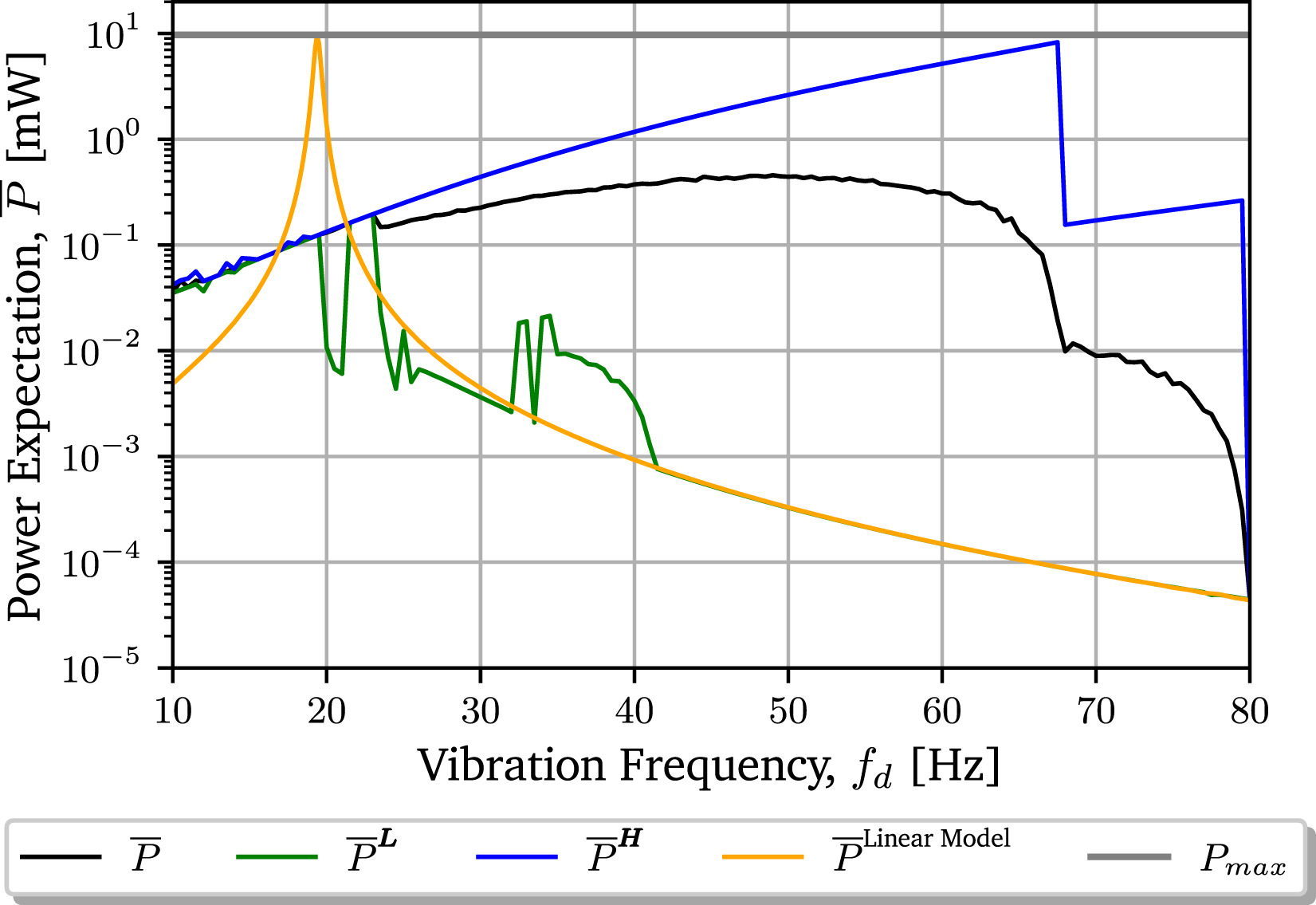 Power expectation as a unified metric for the evaluation of vibration energy harvestersC. Saint-Martin, A. Morel, L. Charleux, and 3 more authorsMechanical Systems and Signal Processing, Dec 2022
Power expectation as a unified metric for the evaluation of vibration energy harvestersC. Saint-Martin, A. Morel, L. Charleux, and 3 more authorsMechanical Systems and Signal Processing, Dec 2022Vibration energy harvesters (VEHs) allow the extraction of ambient mechanical energy. The proposed analysis focuses on bistable harvesters with Duffing nonlinearity. Bistable harvesters exhibit larger frequency bandwidth than linear monostable harvesters, but they exhibit complex behaviors (i.e., multiple periodic orbits and chaos), making their evaluation challenging. To assess the quality of a VEH, it is necessary to evaluate its energy performance generically. In this paper, we offer a new quantitative metric that can be used to evaluate bistable harvesters while taking into account the richness and diversity of their dynamics. This metric – called power expectation – is based on the average harvested power of each existing orbit weighted by its occurrence probability. The value of this power expectation depends on the harvester characteristics and potential orbit jump strategy implemented. Finally, we define a new figure of merit (FoM) based on the integral of the power expectation over all vibration frequencies. This FoM can be used for a generic evaluation of nonlinear vibration energy harvesters (NVEHs), by taking into account the various orbits and their respective probability of occurrence depending on the orbit jump strategy used. The proposed FoM also makes it possible to ensure a fair comparison with linear VEHs and quantitatively assess the effectiveness of orbit jump strategies for a given VEH.
@article{SaintMartin2022, title = {Power expectation as a unified metric for the evaluation of vibration energy harvesters}, volume = {181}, issn = {08883270}, url = {https://linkinghub.elsevier.com/retrieve/pii/S0888327022005957}, doi = {10.1016/j.ymssp.2022.109482}, language = {en}, urldate = {2023-01-03}, journal = {Mechanical Systems and Signal Processing}, author = {Saint-Martin, C. and Morel, A. and Charleux, L. and Roux, E. and Benhemou, A. and Badel, A.}, month = dec, year = {2022}, pages = {109482}, keywords = {acc}, file = {Saint-Martin et al. - 2022 - Power expectation as a unified metric for the eval.pdf:C\:\\Users\\rouxemi\\Zotero\\storage\\TC755BM4\\Saint-Martin et al. - 2022 - Power expectation as a unified metric for the eval.pdf:application/pdf} } -
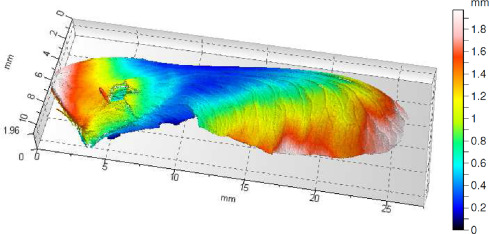 Extending the operating limits and performances of centimetre-scale wind turbines through biomimicryAurélien Carré, Pierre Gasnier, Émile Roux, and 1 more authorApplied Energy, Nov 2022
Extending the operating limits and performances of centimetre-scale wind turbines through biomimicryAurélien Carré, Pierre Gasnier, Émile Roux, and 1 more authorApplied Energy, Nov 2022@article{carre2022, title = {Extending the operating limits and performances of centimetre-scale wind turbines through biomimicry}, volume = {326}, issn = {03062619}, url = {https://linkinghub.elsevier.com/retrieve/pii/S0306261922012533}, doi = {10.1016/j.apenergy.2022.119996}, language = {en}, urldate = {2023-01-03}, journal = {Applied Energy}, author = {Carré, Aurélien and Gasnier, Pierre and Roux, Émile and Tabourot, Laurent}, month = nov, year = {2022}, pages = {119996}, keywords = {acc}, } -
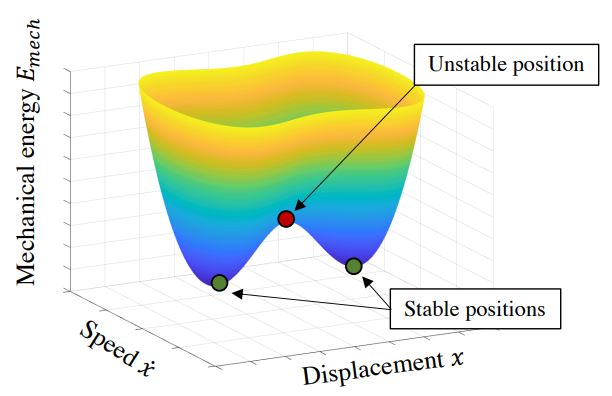 Simple analytical models and analysis of bistable vibration energy harvestersAdrien Morel, Ludovic Charleux, Quentin Demouron, and 7 more authorsSmart Materials and Structures, Sep 2022
Simple analytical models and analysis of bistable vibration energy harvestersAdrien Morel, Ludovic Charleux, Quentin Demouron, and 7 more authorsSmart Materials and Structures, Sep 2022@article{morel2022, title = {{Simple analytical models and analysis of bistable vibration energy harvesters}}, author = {Morel, Adrien and Charleux, Ludovic and Demouron, Quentin and Benhemou, Aya and Gibus, David and Saint-Martin, Camille and Carr{\'e}, Aur{\'e}lien and Roux, {\'E}mile and Huguet, Thomas and Badel, Adrien}, url = {https://hal.science/hal-03765636}, journal = {{Smart Materials and Structures}}, publisher = {{IOP Publishing}}, volume = {31}, number = {10}, pages = {105016}, year = {2022}, month = sep, doi = {10.1088/1361-665X/ac8d3d}, keywords = {Energy harvesting ; Nonlinear dynamics ; Nonlinearity ; Harmonic balance ; Analytical model ; Bi-stability ; Vibrations ; Multiphysics - Modeling ; Electromechanical systems}, hal_id = {hal-03765636}, }
2021
-
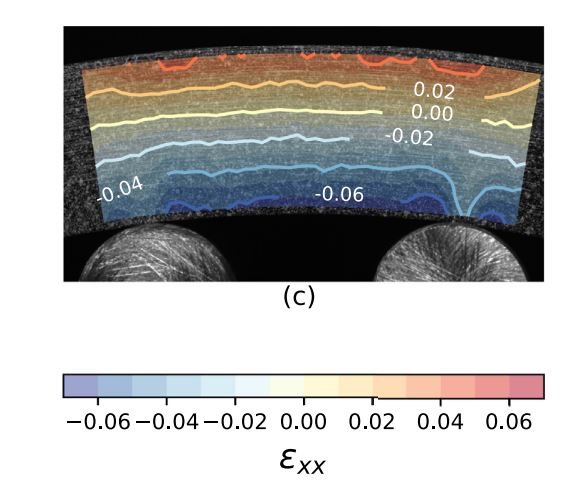 Effect of tension-compression asymmetry of AZ31B magnesium alloys on four-point bendingEmile Roux, Pascale Balland, and Ludovic CharleuxMechanics Research Communications, Sep 2021
Effect of tension-compression asymmetry of AZ31B magnesium alloys on four-point bendingEmile Roux, Pascale Balland, and Ludovic CharleuxMechanics Research Communications, Sep 2021@article{Roux2020a, author = {Roux, Emile and Balland, Pascale and Charleux, Ludovic}, title = {Effect of tension-compression asymmetry of AZ31B magnesium alloys on four-point bending}, journal = {Mechanics Research Communications}, year = {2021}, doi = {https://doi.org/10.1016/j.mechrescom.2021.103672}, keywords = {acc}, } -
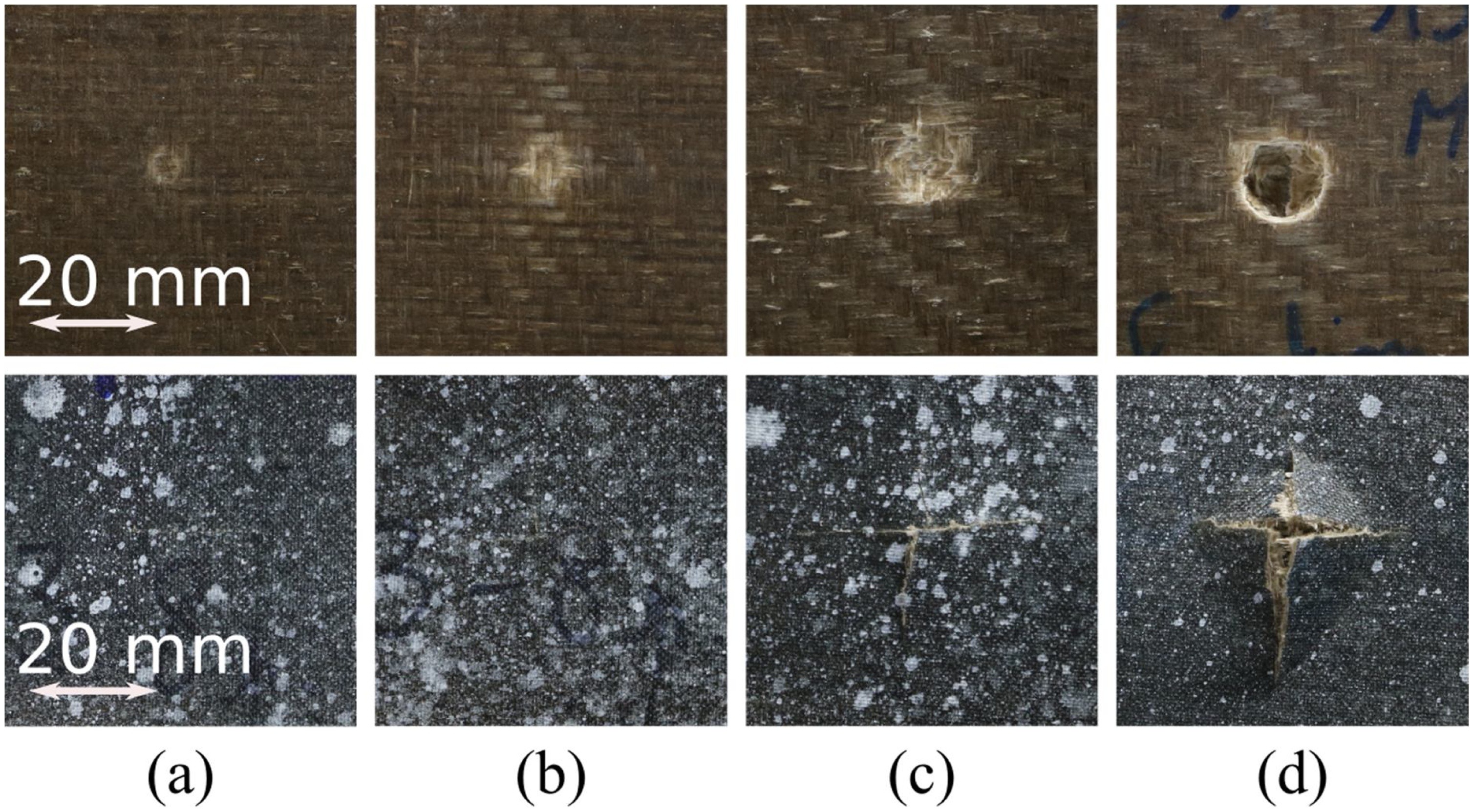 Are there similarities between quasi-static indentation and low velocity impact tests for flax-fibre composites?Adélaïde Leroy, Daniel Scida, Émile Roux, and 2 more authorsIndustrial Crops and Products, Sep 2021
Are there similarities between quasi-static indentation and low velocity impact tests for flax-fibre composites?Adélaïde Leroy, Daniel Scida, Émile Roux, and 2 more authorsIndustrial Crops and Products, Sep 2021Flax-fibre composites are increasingly used as a replacement of classical synthetic composite materials. Due to the good energy absorption properties of flax fibres, they represent a promising alternative in structures susceptible to low velocity impact (LVI) damage. However, this type of dynamic loading is complex, expensive to perform and not necessarily easy to fully investigate. A simpler way to tackle this problem consists in investigating quasi-static indentation (QSI) tests, but this alternative remains relatively under-researched for natural fibre composites. Thus, this paper aims at providing a comparison between both types of loading to facilitate the later analysis and modelling of flax fabric laminates submitted to LVI. Six layers of a flax 2/2 twill fabric were used as reinforcement for epoxy laminates made through vacuum infusion. Specimens were then submitted to instrumented LVI and QSI tests at comparable energy levels, with a 1.5 %–3.9 % difference only. Load-displacement curves and visible damage were first analysed and compared between both test types. Then, the internal damage within QSI specimens were investigated using acoustic emission (AE). Our findings showed good analogies between both testing methods in all the stages of damage development. Great similarities were found in load-displacement curves (in shape, stiffness and peak load), in energy absorption capacity (at 5 and 10 J) and in visible damage. Actually, the differences between QSI and LVI remain low, i.e. 2.1 % for linear stiffness, from 0.2 to 5.6 % for peak load and less than 7% for the proportions of absorbed energy. Comparison of the QSI damage analysed from the AE data with LVI results from literature suggested similar mechanisms and onset sequences. These results revealed that QSI monitoring could provide characteristic indications on the damage evolution of flax-fibre woven composites during an LVI test.
@article{Leroy2021, author = {Leroy, Adélaïde and Scida, Daniel and Roux, Émile and Toussaint, Franck and Ayad, Rezak}, title = {Are there similarities between quasi-static indentation and low velocity impact tests for flax-fibre composites?}, doi = {https://doi.org/10.1016/j.indcrop.2021.113840}, issn = {0926-6690}, pages = {113840}, url = {https://www.sciencedirect.com/science/article/pii/S092666902100604X}, volume = {171}, journal = {Industrial Crops and Products}, keywords = {acc}, year = {2021}, }
2020
-
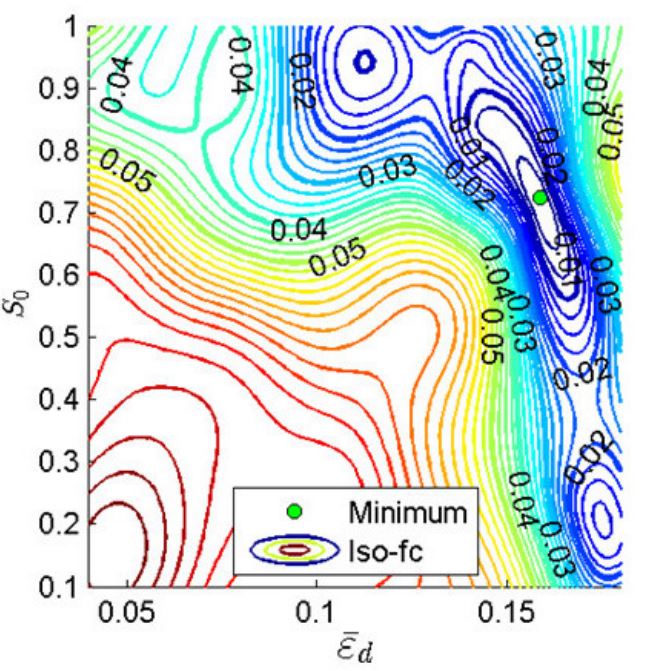 An efficient parallel global optimization strategy based on Kriging properties suitable for material parameters identificationEmile Roux, Yannick Tillier, Salim Kraria, and 1 more authorSep 2020
An efficient parallel global optimization strategy based on Kriging properties suitable for material parameters identificationEmile Roux, Yannick Tillier, Salim Kraria, and 1 more authorSep 2020Material parameters identification by inverse analysis using finite element computations leads to the resolution of complex and time-consuming optimization problems. One way to deal with these complex problems is to use meta-models to limit the number of objective function computations. In this paper, the Efficient Global Optimization (EGO) algorithm is used. The EGO algorithm is applied to specific objective functions, which are representative of material parameters identification issues. Isotropic and anisotropic correlation functions are tested. For anisotropic correlation functions, it leads to a significant reduction of the computation time. Besides, they appear to be a good way to deal with the weak sensitivity of the parameters. In order to decrease the computation time, a parallel strategy is defined. It relies on a virtual enrichment of the meta-model, in order to compute q new objective functions in a parallel environment. Different methods of choosing the qnew objective functions are presented and compared. Speed-up tests show that Kriging Believer (KB) and minimum Constant Liar (CLmin) enrichments are suitable methods for this parallel EGO (EGO-p) algorithm. However, it must be noted that the most interesting speed-ups are observed for a small number of objective functions computed in parallel. Finally, the algorithm is successfully tested on a real parameters identification problem.
@article{Roux2020, author = {Roux, Emile and Tillier, Yannick and Kraria, Salim and Bouchard, Pierre-Olivier}, title = {An efficient parallel global optimization strategy based on Kriging properties suitable for material parameters identification}, doi = {10.24425/ame.2020.131689}, number = {No 2}, pages = {169-195}, url = {http://journals.pan.pl/Content/115021/PDF/AME_2020_131689.pdf}, volume = {vol. 67}, howpublished = {online}, journal = {Archive of Mechanical Engineering}, keywords = {global optimization, parallel computation, Kriging meta-model, inverse analysis, acc}, publisher = {Polish Academy of Sciences, Committee on Machine Building}, type = {Artykuły / Articles}, year = {2020}, } -
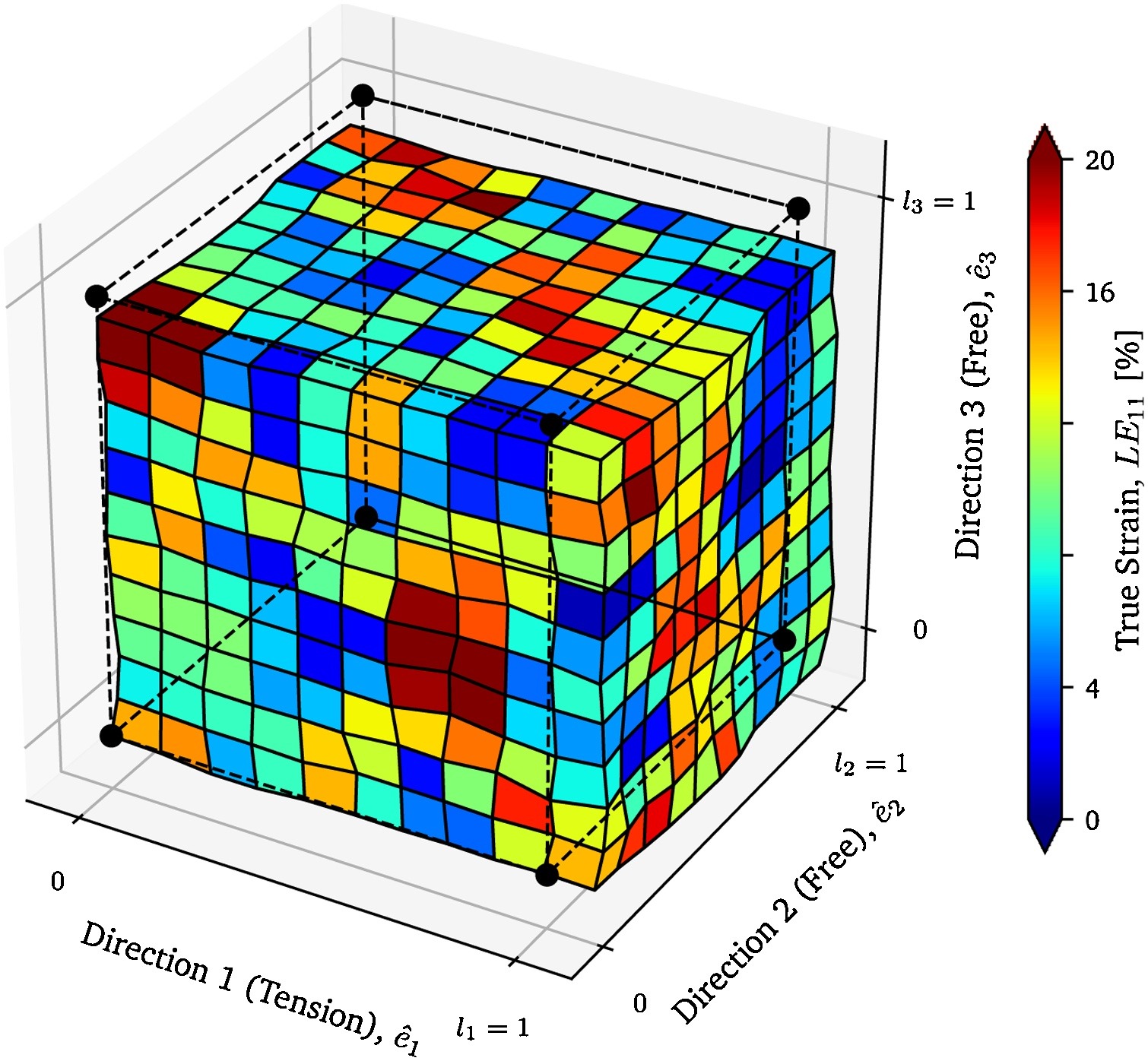 Dependency of the Youngs modulus to plastic strain in DP steels: a consequence of heterogeneity?Ludovic Charleux, Laurent Tabourot, Emile Roux, and 2 more authorsMaterials Today Communications, Sep 2020
Dependency of the Youngs modulus to plastic strain in DP steels: a consequence of heterogeneity?Ludovic Charleux, Laurent Tabourot, Emile Roux, and 2 more authorsMaterials Today Communications, Sep 2020@article{Charleux2020, author = {Charleux, Ludovic and Tabourot, Laurent and Roux, Emile and Farah, Moustapha Issack and Bizet, Laurent}, title = {Dependency of the Youngs modulus to plastic strain in {DP} steels: a consequence of heterogeneity?}, journal = {Materials Today Communications}, year = {2020}, pages = {100972}, doi = {10.1016/j.mtcomm.2020.100972}, url = {https://doi.org/10.1016/j.mtcomm.2020.100972}, keywords = {acc}, publisher = {Elsevier {BV}}, }
2018
-
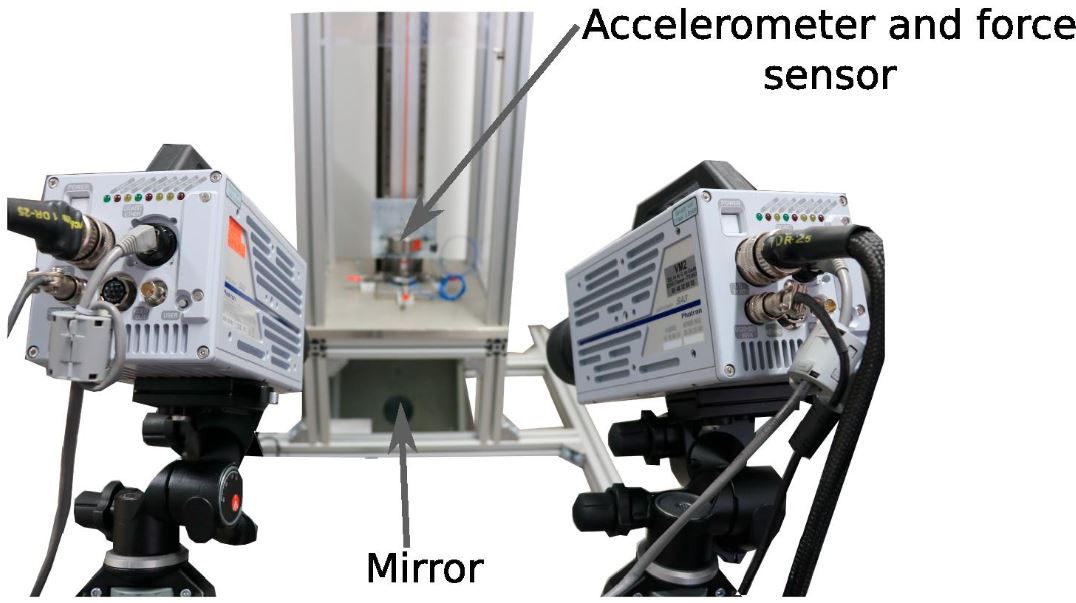 Damage characterisation of flax fibre fabric reinforced epoxy composites during low velocity impacts using high-speed imaging and Stereo Image CorrelationAmélie Cuynet, Daniel SCIDA, Émile Roux, and 3 more authorsComposite Structures, Sep 2018
Damage characterisation of flax fibre fabric reinforced epoxy composites during low velocity impacts using high-speed imaging and Stereo Image CorrelationAmélie Cuynet, Daniel SCIDA, Émile Roux, and 3 more authorsComposite Structures, Sep 2018@article{Cuynet2018, author = {Cuynet, Am{\'{e}}lie and SCIDA, Daniel and Roux, {\'{E}}mile and Toussaint, Franck and Ayad, Rezak and Lagache, Manuel}, title = {{Damage characterisation of flax fibre fabric reinforced epoxy composites during low velocity impacts using high-speed imaging and Stereo Image Correlation}}, journal = {Composite Structures}, year = {2018}, doi = {10.1016/j.compstruct.2018.05.090}, url = {http://hal.univ-smb.fr/hal-01814975}, keywords = {acc}, publisher = {Elsevier}, }
2015
- On the interest of using full field measurements in ductile damage model calibrationEmile Roux, and Pierre-Olivier BouchardInternational Journal of Solids and Structures, Sep 2015
This paper is focused on the identification method by inverse analysis of ductile damage model parameters. The Lemaitre damage model is considered. The aim is to assess the interest of using local measurements, such as full field measurements, in the calibration process. Basic approach using only load-displacement measurements from a tensile test is first described and discussed. Secondly necking measurements are added in the calibration process. And finally an inverse analysis approach including full field measurements in a large deformation framework is presented. For each step particular attention is paid to the definition of the objective function to catch efficiently the softening behavior and the fracture of the sample. This step-by-step approach allows understanding the lack of information embedded in the load-displacement curve to calibrate such a model. It also highlights the multi-extrema aspect of the optimization problem. The introduction of local measurements, as necking and even more as displacement fields, is an efficient way of overcoming this lack of information. The analysis is based on kriging response-surfaces built during the minimization of the objective function. These surfaces highlight the weak sensitivity of one of the Lemaitre model parameters (the b parameter) when only the load-displacement curve is taken into account. The sensitivity is then improved when local measurements are considered. The use of local measurement also leads to the removal of correlation between model parameters.
@article{Roux2015, author = {Roux, Emile and Bouchard, Pierre-Olivier}, title = {{On the interest of using full field measurements in ductile damage model calibration}}, doi = {10.1016/j.ijsolstr.2015.07.011}, issn = {00207683}, pages = {50--62}, url = {https://hal-mines-paristech.archives-ouvertes.fr/hal-01183968 http://dx.doi.org/10.1016/j.ijsolstr.2015.07.011}, volume = {72}, file = {:C$\backslash$:/Users/rouxemi/AppData/Local/Mendeley Ltd./Mendeley Desktop/Downloaded/Roux, Bouchard - 2015 - On the interest of using full field measurements in ductile damage model calibration.pdf:pdf}, isbn = {0020-7683}, journal = {International Journal of Solids and Structures}, keywords = {Ductile damage model, Full field measurements, Inverse analysis, Parameter identification}, publisher = {Elsevier}, year = {2015}, } - Analysis of ASB assisted failure in a high strength steel under high loading rateEmile Roux, Patrice Longère, Olivier Cherrier, and 3 more authorsMaterials & Design, Sep 2015
In the present work, the engineering, high strength ARMOX500T steel was submitted to a Kalthoff and Winkler type impact test in view of evaluating its crack arrest capability under dynamic loading. From an impact velocity of the order of 150m/s, the crack propagation is seen to be preceded by adiabatic shear banding (ASB) leading to a premature plate failure. The whole chronology of the plate failure mechanisms (weak localization, strong localization in the form of ASB then cracking) was observed thanks to the use of an ultra-high speed camera. Further digital image analysis allows for establishing displacement fields describing the kinematics induced by both adiabatic shear banding and crack propagation, in the perspective of being implemented into an embedded band/crack based model in the context of dynamic plasticity and fracture.
@article{Roux2015a, author = {Roux, Emile and Long{\`{e}}re, Patrice and Cherrier, Olivier and Millot, Thierry and Capdeville, Didier and Petit, Jacques}, title = {{Analysis of ASB assisted failure in a high strength steel under high loading rate}}, doi = {10.1016/j.matdes.2015.03.025}, issn = {02613069}, pages = {149--159}, url = {http://www.sciencedirect.com/science/article/pii/S0261306915001144}, volume = {75}, file = {:C$\backslash$:/Users/rouxemi/AppData/Local/Mendeley Ltd./Mendeley Desktop/Downloaded/Roux et al. - 2015 - Analysis of ASB assisted failure in a high strength steel under high loading rate.pdf:pdf}, isbn = {0261-3069}, journal = {Materials {\&} Design}, keywords = {Adiabatic shear banding, Digital image analysis, Experiment, Fracture, Impact, Steel}, publisher = {Elsevier Ltd}, year = {2015}, }
2014
- A new finite element approach for modelling ductile damage void nucleation and growth-analysis of loading path effect on damage mechanismsEmile Roux, Modesar Shakoor, Marc Bernacki, and 1 more authorModelling and Simulation in Materials Science and Engineering, Sep 2014
A two-dimensional finite element (FE) model is presented to model the nucleation and void growth stages in ductile damage phenomena on the microstructure scale. This model is based on a level-set (LS) method coupled with an advanced re-meshing strategy. Both nucleation modes (interface debonding and inclusion fracture) are modelled through the introduction of micro-voids according to stress-based criteria. The LS method and mesh adaptation are used to accommodate the topology modification of the microstructure and to model multiple void nucleation and growth for different loading paths. The enhanced FE model is adopted to analyse the key features of the damage mechanisms on the micro-scale. The effects of inclusion orientation and of a complex loading path on nucleation and void growth are addressed. Good agreement is found with available experimental and numerical data found in the literature. The results exhibit that the loading path is a key point in damage growth. The proposed FE framework is an efficient technique to study damage phenomena on both simple and realistic microstructures. In the future, such an approach can be used to calibrate macroscopic ductile damage models for a complex loading path.
@article{Roux2014, author = {Roux, Emile and Shakoor, Modesar and Bernacki, Marc and Bouchard, P.-O.}, title = {{A new finite element approach for modelling ductile damage void nucleation and growth-analysis of loading path effect on damage mechanisms}}, doi = {10.1088/0965-0393/22/7/075001}, issn = {0965-0393}, number = {7}, pages = {Article 075001}, url = {http://stacks.iop.org/0965-0393/22/i=7/a=075001?key=crossref.a6dd724d6f5903066b22eafaa716e8bd https://hal-mines-paristech.archives-ouvertes.fr/hal-01090403}, volume = {22}, file = {:C$\backslash$:/Users/rouxemi/AppData/Local/Mendeley Ltd./Mendeley Desktop/Downloaded/Roux et al. - 2014 - A new finite element approach for modelling ductile damage void nucleation and growth—analysis of loading path effe.pdf:pdf}, journal = {Modelling and Simulation in Materials Science and Engineering}, keywords = {00, 075001, 0965-0393, 14, 23, 33, anisotropic meshing and re-meshing, ductile damage, finite element method, in colour only in, inclusions, level set, loading path dependency, nucleation, some figures may appear, the online journal}, publisher = {IOP Publishing}, year = {2014}, }
2013
- Kriging metamodel global optimization of clinching joining processes accounting for ductile damageEmile Roux, and Pierre-Olivier BouchardJournal of Materials Processing Technology, Sep 2013
Clinching is a very cheap and efficient cold forming process that enables to join two sheets without any additional part such as a rivet or a bolt. This paper deals with the optimization of the final mechanical strength of a joined component using a global optimization technique based on Kriging meta-model. The optimization process includes both the joining stage and the mechanical strength simulations. It is shown that accounting for plastic strain, residual stresses and damage occurring during clinching is essential if one wants to study the final mechanical strength of the clinched component. The global optimization leads to a 13.5% increase of the mechanical strength for tensile loading and to 46.5% increase for shear loading. The global optimization procedure also enables to study the influence of input geometrical variability on the final mechanical strength, which is essential from an industrial point of view. ?? 2013 Elsevier B.V.
@article{Roux2013a, author = {Roux, Emile and Bouchard, Pierre-Olivier}, title = {{Kriging metamodel global optimization of clinching joining processes accounting for ductile damage}}, doi = {10.1016/j.jmatprotec.2013.01.018}, issn = {09240136}, number = {7}, pages = {1038--1047}, url = {https://hal-mines-paristech.archives-ouvertes.fr/hal-00805670}, volume = {213}, file = {:C$\backslash$:/Users/rouxemi/AppData/Local/Mendeley Ltd./Mendeley Desktop/Downloaded/Roux, Bouchard - 2013 - Kriging metamodel global optimization of clinching joining processes accounting for ductile damage.pdf:pdf}, journal = {Journal of Materials Processing Technology}, keywords = {Clinching joining process, Ductile damage, Global optimization, Kriging meta-model}, publisher = {Elsevier}, year = {2013}, } - A level-set and anisotropic adaptive remeshing strategy for the modeling of void growth under large plastic strainEmile Roux, Marc Bernacki, and Pierre-Olivier BouchardComputational Materials Science, Sep 2013
A numerical model based on the use of a level set framework coupled with an anisotropic re-meshing technique is presented in order to describe the void growth process for 2D and 3D configurations. Interfaces of inclusions and voids are described implicitly using level set functions. An anisotropic meshing - remeshing strategy is employed to track interfaces and ensure the accuracy of finite element calculations. The matrix and inclusions are elastic-plastic materials. The numerical methodology is adopted to study the effect of different parameters such as void or inclusion orientation and domain size. A good agreement is found with available experimental data and those found in the literature. The proposed method is shown to be an efficient promising technique to study ductile damage stages as void nucleation and growth. A demonstration of the method potential is illustrated by studying void growth for a 2D real complex microstructure and for a simple 3D microstructure. \textcopyright 2012 Elsevier B.V. All rights reserved.
@article{Roux2013, author = {Roux, Emile and Bernacki, Marc and Bouchard, Pierre-Olivier}, title = {{A level-set and anisotropic adaptive remeshing strategy for the modeling of void growth under large plastic strain}}, doi = {10.1016/j.commatsci.2012.10.004}, issn = {09270256}, pages = {32--46}, url = {http://dx.doi.org/10.1016/j.commatsci.2012.10.004 https://hal-mines-paristech.archives-ouvertes.fr/hal-00756435}, volume = {68}, file = {:C$\backslash$:/Users/rouxemi/AppData/Local/Mendeley Ltd./Mendeley Desktop/Downloaded/Roux, Bernacki, Bouchard - 2013 - A level-set and anisotropic adaptive remeshing strategy for the modeling of void growth under large pl.pdf:pdf}, isbn = {0927-0256}, journal = {Computational Materials Science}, keywords = {Anisotropic meshing, Ductile damage, Finite element method, Inclusions, Level set, Void growth}, publisher = {Elsevier}, year = {2013}, } - Three-dimensional analysis of real void closure at the meso-scale during hot metal forming processesMichel Saby, Marc Bernacki, Emile Roux, and 1 more authorComputational Materials Science, Sep 2013
Abstract In the metal forming industry, elimination of internal defects is a prerequisite to avoid catastrophic failure of workpieces. The two different approaches used in the literature to study void closure, respectively at the process-scale and void-scale, present a certain number of limitations. In this paper, an alternative method is presented at a meso-scale. Simulations are performed using a Representative Volume Element (RVE) with real void geometries generated from 3D images obtained using computed microtomography. Complex mechanical loadings are imposed using advanced boundary conditions coming from process numerical modeling. The simulations provide very accurate results to model void closure in real industrial conditions. Equivalent spherical and ellipsoidal voids are also generated and void volume evolution is compared to the case of real geometries. It is shown that the global tendency of void closure is well respected, even though the use of a sphere underestimates void closure, whereas an ellipsoid overestimates void closure, on the final stage. A sensitivity study to mechanical parameters shows that strain-rate has no major influence, while stress triaxiality ratio exhibits a strong influence on the closure of real void. Non-uniform boundary conditions also applied to demonstrate that most existing predictive models are unable to predict void closure in non-uniform mechanical loadings.
@article{Saby2013, author = {Saby, Michel and Bernacki, Marc and Roux, Emile and Bouchard, Pierre-Olivier}, title = {{Three-dimensional analysis of real void closure at the meso-scale during hot metal forming processes}}, doi = {10.1016/j.commatsci.2013.05.002}, issn = {09270256}, pages = {194--201}, url = {http://linkinghub.elsevier.com/retrieve/pii/S0927025613002358 https://hal-mines-paristech.archives-ouvertes.fr/hal-00831553}, volume = {77}, file = {:C$\backslash$:/Users/rouxemi/AppData/Local/Mendeley Ltd./Mendeley Desktop/Downloaded/Saby et al. - 2013 - Three-dimensional analysis of real void closure at the meso-scale during hot metal forming processes.pdf:pdf}, journal = {Computational Materials Science}, keywords = {Finite elements, Hot metal forming, Meso-scale, Void closure}, publisher = {Elsevier}, year = {2013}, }